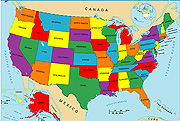
WEDNESDAY, April 24 (HealthDay News) — People who live in the so-called “stroke belt” during their teen years are at increased risk for stroke later in life, according to a new study.
The stroke belt is an area in the southeastern United States with higher rates of stroke and stroke death than anywhere else in the country. Only part of that increased risk can be explained by traditional risk factors such as high blood pressure and diabetes, the researchers said.
Previous studies have found that adults who were born in the stroke belt but no longer live there have a higher risk of stroke, as well as people who were not born in the stroke belt but lived there as adults.
This new study included more than 24,000 people with an average age of 65 and no previous history of stroke. About 57 percent of them lived in the stroke belt and 43 percent in other parts of the country. The study authors looked at where the participants had lived during their lives.
The people were followed for an average of nearly six years after enrolling in the study. During the follow-up, more than 600 of them had a first stroke.
After adjusting for various stroke risk factors, the researchers concluded that living in the stroke belt only as a teen was associated with a higher risk of stroke. Study participants who lived in the stroke belt when they were teens were 17 percent more likely to suffer a stroke than those who did not spend their teen years in the stroke belt.
In all age groups, living in the stroke belt increased the risk of stroke among blacks about twice as much as among whites, according to the study, which was published online April 24 in the journal Neurology.
The findings suggest that efforts to prevent stroke need to start early in life, said study author Virginia Howard, with the School of Public Health at the University of Alabama at Birmingham.
“Many social and behavioral risk factors, such as smoking, are set in place during the teenage years, and teens are more exposed to external influences and gain the knowledge to challenge or reaffirm their childhood habits and lifestyle,” Howard said in a journal news release.
Although the study tied living in the stroke belt as a teen to higher risk of future stroke, it did not prove a cause-and-effect relationship.
More information
The U.S. National Institute of Neurological Disorders and Stroke has more about stroke risk factors and prevention.

